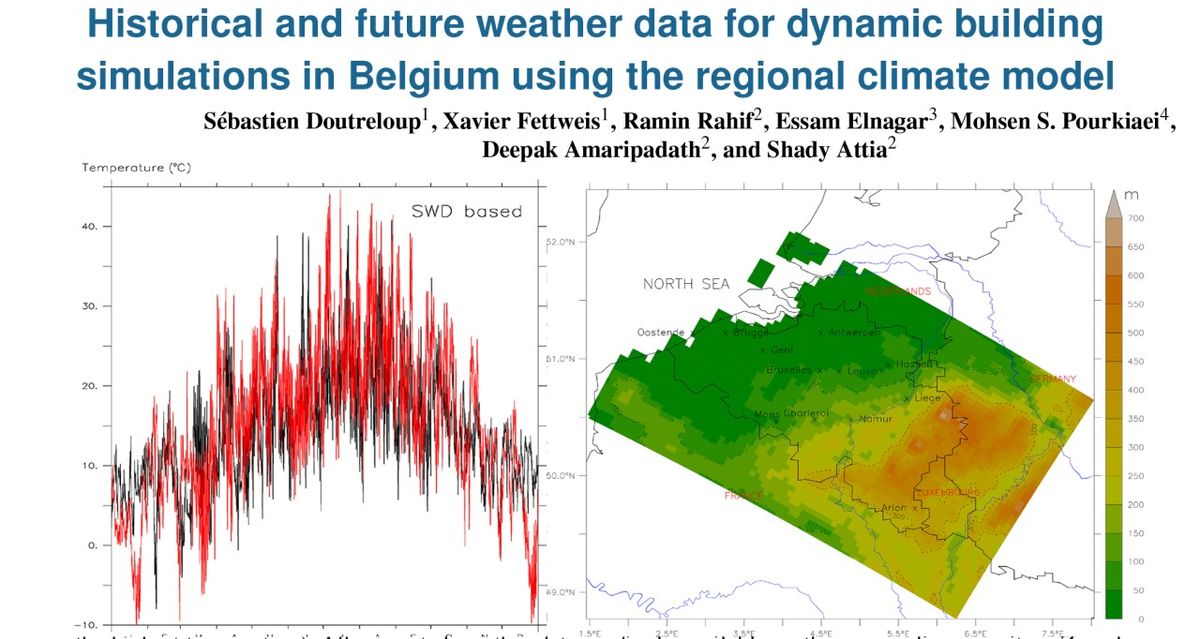Historical and future weather data for dynamic building simulations in Belgium: typical and extreme meteorological years and heatwaves

Climate change already happening, and the only way to make our buildings climate-proof is by testing our design against future climate scenarios. In this novel study, the climatology scientist of Liege University developed a dataset of future weather files based on the latest IPCC 2021 report taking into account different SSP scenarios. Shared Socioeconomic Pathways (SSPs) are scenarios of projected socioeconomic global changes up to 2100.
In collaboration with building engineers, a dataset of Typical Meteorological Year (TMY) and Xtreme Typical Meteorological Year (XMY) files were generated. The ISO-15927 procedure and algorithms were adopted, and the Finkelstein–Schafer statistic was used as a basic statistic selector. Moreover, we created a series of short and extreme short events files representing heat waves. The generated weather data cover Belgian cities and are freely available on the open online repository Zenodo (https://doi.org/10.5281/zenodo.5606983, Doutreloup, and Fettweis, 2021), and these data are produced within the framework of the research project #OCCuPANt: https://www.occupant.uliege.be/.
📣 Read and share the 📄 paper: https://orbi.uliege.be/handle/2268/293076
Abstract: Increasing temperatures due to global warming will influence building, heating, and cooling practices. Therefore, this data set aims to provide formatted and adapted meteorological data for specific users who work in building design, architecture, building energy management systems, modeling renewable energy conversion systems, or others interested in this kind of projected weather data. These meteorological data are produced from the regional climate model MAR (Modèle Atmosphérique Régional in French) simulations. This regional model, adapted and validated over Belgium, is forced firstly by the ERA5 reanalysis, which represents the closest climate to reality, and secondly by three Earth system models (ESMs) from the Sixth Coupled Model Intercomparison Project database, namely, BCC-CSM2-MR, MPI-ESM.1.2, and MIROC6. The main advantage of using the MAR model is that the generated weather data have a high resolution (hourly data and 5 km) and are spatially and temporally homogeneous. The generated weather data follow two protocols. On the one hand, the Typical Meteorological Year (TMY) and eXtreme Meteorological Year (XMY) files are generated largely inspired by the method proposed by the standard ISO15927-4, allowing the reconstruction of typical and extreme years while keeping a plausible variability of the meteorological data. On the other hand, the heatwave event (HWE) meteorological data are generated according to a method used to detect the heatwave events and to classify them according to three criteria of the heatwave (the most intense, the longest duration, and the highest temperature).
Keywords: General Earth and Planetary Sciences
Citation: Doutreloup, S., Fettweis, X., Rahif, R., El Nagar, E., Pourkiaei, S. M., Amaripadath, D., & Attia, S. (2022). Historical and future weather data for dynamic building simulations in Belgium using the regional climate model MAR: typical and extreme meteorological years and heatwaves. Earth System Science Data, 14(7).
The article📄 was developed by Sébastien Doutreloup, Xavier Fettweis, Ramin Rahif, Essam Elnagar, Mohsen Pourkiaei, Deepak Amaripadath, and Shady Attia.
Subscribe to my mailing list: www.shadyattia.org
Look at my ☑️ recent posts' activities. https://lnkd.in/eR-jiXtR
#future #weatherdata #heatwave #dataset #TMY #XMY #Belgium #buildingsimulation